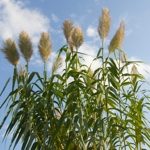Arundo donax
Giant reed Δόναξ

Poaceae - grass family Monocot.
Arundo donax
Giant reed Δόναξ

Poaceae - grass family Monocot.
Growing up to 8 metres tall Giant reed (Arundo donax) forms dense stands, a prominent feature of the Skopelitian countryside. Once regarded as a Mediterranean native, giant reed is now considered to have been introduce into the Mediterranean Basin in prehistoric times, spreading along with civilisation throughout the region from the Indus Valley in what is now Iraq. It has since spread throughout most of the world including America and Australia and is regarded as one of the most invasive species in the world, crowding out native species, particularly in riparian environments. Historically Traditionally reeds had many uses: in construction, as roofing, fences for making baskets, walking sticks, fishing rods. More recently it has been used for biomass power generation. One of the most interesting uses has been for musical wind instruments, including pan pipes. It is still valued as the source of reeds for wind instruments.


The Ancient Myth Pan
Pan, the god of nature, was tending his flock of sheep in Arcadia when he spied the beautiful naiad , Syrinx. She was a hunter and as a follower of Artemis she valued her virginity. Pan approached to woo her, but she was horrified by his ugliness and fled. Pan chased her and she called out to the other nymphs to save her, plunging into a river she was transformed into a bed of reeds. Pan sat weeping by the stream and heard mournful music created by the wind blowing across the hollow reeds. He cut the reeds into different lengths and created the first pan pipes and called them in Greek, Syrinx.
Arundo - Latin for reed
donax - Greek for reed (δόναξ)
